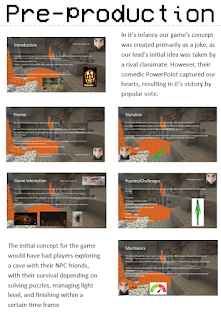Norwich Games Festival: a retrospective
From the 30th of May to the 1st of June, our group presented our game at the Norwich Games Festival. Here I would like to share my contribution to and experience with the event, as well as the feedback we received.
Firstly, my largest contribution to the event was writing the design document, which detailed the overall process of making the game, from the initial presentation to the finishing touches.
The first 2 pages detail the pre-production of the game. This primarily features the initial presentation, the early maps for the first areas, and the initial concept for what the story would look like. Many of these elements have since been overwritten by more recent ideas, however these early steps are still essential to understanding the development of our game, so I found it very important to include them as a baseline for later developments.
The second section details the early development of the game. This includes the early visual design, like the pixelated filter, early development of the first level in accordance with the fantasy theme we were initially going with, and the early monster designs, intended as uncanny corruptions of the human form. While some of these elements were left behind, many of them, like the pixelated filter, the mechanical design of the first level and the theme of the monster carried over into the finished product. this illustrates how over the course of game development, stronger ideas persevere to the final product, whereas weaker ideas are cut and replaced.
The final section details the last developments in the project, and how we came to the finished product. This section showcases the maps of the last 2 areas we made, as well as detailing how we had to abandon the last level due to time constraints. The section also touches on other later additions, such as the change to a less fantastical theme, the completion of the introductory level, and the completion of the monster's design. These all illustrate the extent to which a game can change, even in the last stretch of development.Overall, this document illustrates the journey our game has taken, from a joke presentation, to a retro horror puzzle game, and all the steps in-between. It shows the reader that the process of game design isn't linear and straightforward. It's messy, complicated, and you often end up with a very different game than what you first imagined, and that's ok.
While we were at the event, we had the chance to receive feedback from play-testers who wanted to play our game. Of the feedback we received, 2 were repeated consistently:
1. the game lacks direction. At no point is the player told where they have to go, what they have to do, or anything similar. Players often needed direct advice from team members on what they had to do or where they had to go at any given point in the game. This is something we didn't consider enough in development, as whenever we playtest the game, we already knew what to do.
2. The mechanics are janky. In certain areas, the lack of direction is made worse by the mechanics not working how one would expect them to work. For example, in the introductory level, the key cannot be inserted into the power box head on. rather, it has to be inserted at a 45-70 degree angle from the left. then, the player often thinks the puzzle is done, and has to be directed back to pull the lever on the power box, generally leaving the player feeling annoyed before they've finished the intro. This problem persists throughout the game in other ways, and often confuses and irritates players.
From these criticisms, the most important takeaway is that more thought needs to be put into polishing a game and making sure it not just works, but works smoothly and intuitively. Our game was functional when it was shown off, but the lack of polish lead to players being confused and frustrated trying to parse the intended path forward, through unintuitive mechanics and lack of narration or other directive indicators.
If we could go back to keep working on the game, I would suggest adding some kind of indicator detailing the current objective, as well as thoroughly polish the game to be more intuitive and responsive to player input.










Comments
Post a Comment